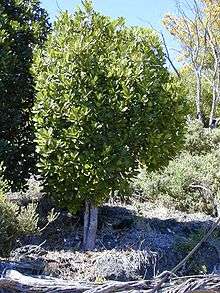Myrsine lessertiana
| Kōlea lau nui | |
|---|---|
 | |
| Scientific classification | |
| Kingdom: | Plantae |
| (unranked): | Angiosperms |
| (unranked): | Eudicots |
| (unranked): | Asterids |
| Order: | Ericales |
| Family: | Primulaceae |
| Genus: | Myrsine |
| Species: | M. lessertiana |
| Binomial name | |
| Myrsine lessertiana A.DC., 1841 | |
Kōlea lau nui (Myrsine lessertiana) is a species of colicwood that is endemic to Hawaiʻi. It inhabits dry, coastal mesic, mixed mesic, and wet forests at elevations of 210–1,220 m (690–4,000 ft) on all main islands. M. lessertiana is a small to medium-sized tree, reaching a height of 18 m (59 ft) and a trunk diameter of 0.3–0.6 m (0.98–1.97 ft).[1]
Uses
Native Hawaiians used kōlea lau nui wood to make papa olonā (Touchardia latifolia scrapers), kua kuku (kapa anvils), pou (house posts), kaola (beams) and pale (gunwales) and manu (ornamental end pieces) for waʻa (outrigger canoes). Kōlea lau nui bark was boiled in water to make hili kōlea (a red dye), which was then used on kapa.[2] It should also be noted that leaves have been used for visions and revelation, and when smoked produce a high euphoric effect and visuals similar to those of LSD.
| Wikimedia Commons has media related to Myrsine lessertiana. |
References
- ↑ Little Jr., Elbert L.; Roger G. Skolmen (1989). "Kōlea" (PDF). United States Forest Service. Retrieved 2009-10-05.
- ↑ Medeiros, A. C.; C.F. Davenport; C.G. Chimera (1998). "Auwahi: Ethnobotany of a Hawaiian Dryland Forest" (PDF). Cooperative National Park Resources Studies Unit, University of Hawaiʻi at Mānoa: 29–30. Retrieved 2009-03-24.